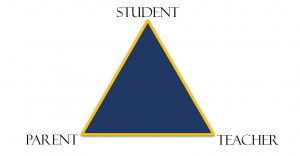INSIGHT: Parent-Teacher-Student Conferences
By Dr. John Stegeman, Head of Upper School
Parents and educators share the goal of guiding adolescents toward independence. We are more than happy to help our students solve a tricky new math problem, or clarify a nuanced thesis statement, but ultimately, we want young people to overcome challenges and perform for themselves. In the process, though, we form a critical partnership to supports students through the necessary discomfort and uncertainty of learning. That partnership requires communication, and the fall Parent-Teacher-Student Conferences brought parents and teachers together to speak directly with students about how school is going early in the year.
What does each party bring to the table at those conferences? By their senior year, students should be able to lead the conversation and speak reflectively to parents and teachers about the  skills and knowledge they are acquiring, the challenges they are facing, and goals they are working toward. Younger students might need parents and teachers to pose more questions to draw out those insights, but adults should try not to substitute their own thoughts for student reflection. Parents and teachers should probably do more listening than speaking. It can be hard to sit through an awkward silence, but students need time and space to really execute the difficult work of critical reflection. For that reason, we hope that fall conferences serve primarily as the start of a reflective conversation that takes place across the school year between parents, teachers and students.
skills and knowledge they are acquiring, the challenges they are facing, and goals they are working toward. Younger students might need parents and teachers to pose more questions to draw out those insights, but adults should try not to substitute their own thoughts for student reflection. Parents and teachers should probably do more listening than speaking. It can be hard to sit through an awkward silence, but students need time and space to really execute the difficult work of critical reflection. For that reason, we hope that fall conferences serve primarily as the start of a reflective conversation that takes place across the school year between parents, teachers and students.
How does the conversation unfold subsequent to the fall conference? At Eastside Prep, we provide formal feedback to parents and students at least twice each trimester, through end-of-term reports, mid-term reports, narrative comments, conferences, or a combination of those mediums. In the interim, students receive direct feedback from teachers on class contributions and submitted work. Parents are able to view much of that feedback through Canvas, our learning management system. We ask teachers and advisors to contact parents by phone or email if they have a concern about student progress or behavior, and we want parents to feel welcome and comfortable reaching out to teachers any time they have questions or concerns.
What is the effect on the student when parents and teachers communicate directly? It can be tempting to ask students to manage school on their own, and indeed students cannot fully develop independence unless the adults in their lives gradually withdraw. But the slow and steady reduction of adult support is not a linear process. It must constantly be tuned to the student’s rate of growth, which accelerates and plateaus throughout their development. In addition to the uneven curve of cognitive, emotional, and physical maturation, students are responding to myriad personal, social, and environmental changes. Consistent communication between parents and teachers helps identify needs and challenges in support of students. Our practice almost always starts with direct communication to the student, and we think it’s usually best to let students know that parents and teachers are in contact.
As the year unfolds, we invite you to stay in touch with us about your student’s progress. Send us a note, pick up the phone, or stop by one of our many parent events in the coming weeks and months. Thank you for your continued support of EPS, and we look forward to seeing you again soon.

